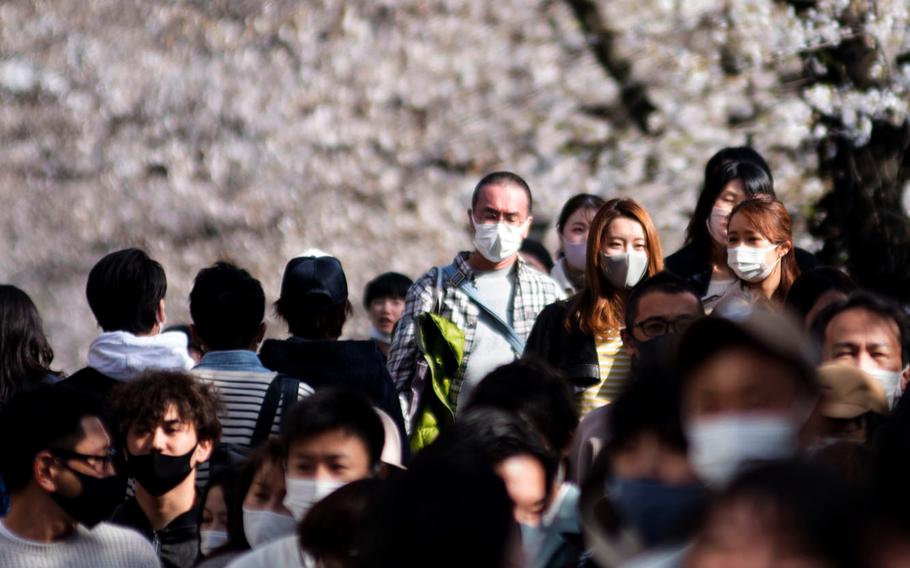
The coronavirus did not stop crowds from turning out to see cherry blossoms in central Tokyo on March 24, 2021. (Akifumi Iskhikawa/Stars and Stripes)
Stars and Stripes is making stories on the coronavirus pandemic available free of charge. See more staff and wire stories here. Sign up for our daily coronavirus newsletter here. Please support our journalism with a subscription.
TOKYO — The number of people newly infected with COVID-19 inched higher in Japan and South Korea, even as new cases on U.S. military bases in those countries remained low over the weekend.
Two U.S. bases in Japan reported three new cases of COVID-19, the coronavirus respiratory disease, between 6 p.m. Friday and 6 p.m. Monday.
Tokyo reported 234 new coronavirus patients Monday, 47 more than the same day the previous week, according to public broadcaster NHK. The city for 10 days has reported more new cases each day than a week earlier, according to metro government data. More than 120,000 people have contracted the virus in Tokyo during the pandemic, NHK reported.
Overall, the number of newly infected people in Japan jumped from 1,289 Thursday to 2,026 on Saturday, according to the World Health Organization. Though higher by several hundred, the Saturday total is short of the one-day peak, thus far, of 7,855 on Jan. 9. According to WHO, more than 9,031 people have died of coronavirus complications in Japan.
South Korea experienced a similar rise in one-day new case numbers, reaching 505 on Saturday, the highest count since 621 on Feb. 18, according to WHO. South Korea on Monday reported 370 new patients with COVID-19, according to the Korea Disease Control and Prevention Agency.
Numbers of newly infected patients held steady at 105 in Seoul and 130 in Gyeonggi province, where Camp Humphreys and Osan Air Base are located, according to KDCA.
In Japan, Marine Corps Air Station Iwakuni, near Hiroshima, reported one person, a recent arrival to Japan, tested positive before the end of the 14-day mandatory quarantine period, according to an air station Facebook post Monday.
Iwakuni has reported five new coronavirus patients since Thursday.
Kadena Air Base on Okinawa on Friday reported two people tested positive, one after becoming ill with COVID-19 symptoms and the other after close contact with another infected person, according to a base Facebook post. An unspecified number of close contacts were quarantined, according to the base.
Twenty-two people at Kadena have tested positive for the virus so far in March.
Friday, two top-ranked Pentagon health officials said the Defense Department expects to offer all its people the vaccine by May and have nearly all vaccinated by July.
DOD has administered 1.8 million shots to eligible personnel, Dr. Terry Adirim, acting assistant secretary of defense for health affairs, said at a media briefing. Some people who declined the vaccine at first have changed their minds, she said.
“Like the civilian sector, early on we were aware that some service members were hesitant to accept vaccination,” she said. “But now we are seeing more and more step forward to get it when it’s their turn.”
Some people passed on two or three opportunities before becoming vaccinated, Army Lt. Gen. Ronald Place, a physician and director of the Defense Health Agency, said at the same briefing.
Pressed for a specific rate of DOD people declining vaccines, Place said those numbers are not tracked.
Instead, he said, the number of people being vaccinated in each category of the DOD priority list, or schema, increases each time the vaccines are offered, meaning some who declined it are stepping forward later.
“All we track is those who accept it,” he said.
Place pushed back on a question about the one-shot, Johnson & Johnson, or Janssen, vaccine being inferior to the Moderna and Pfizer-BioNTech vaccines. The Johnson & Johnson and Moderna vaccines are now being offered to eligible DOD personnel in Japan and South Korea.
The Pfizer and Moderna vaccines, at 95% and 94.1% efficacy, respectively, scored higher than Johnson & Johnson at 72%, but Place said that alone is an incomplete comparison.
“None of these vaccines have been truly measured in the exact same circumstances,” he said, “so we would really caution anyone from comparing any efficacy or safety or any other factor of any of the vaccines against each other because it’s not been done.”
Stars and Stripes reporter Yoo Kyong Chang contributed to this report.
ditzler.joseph@stripes.com Twitter: @JosephDitzler